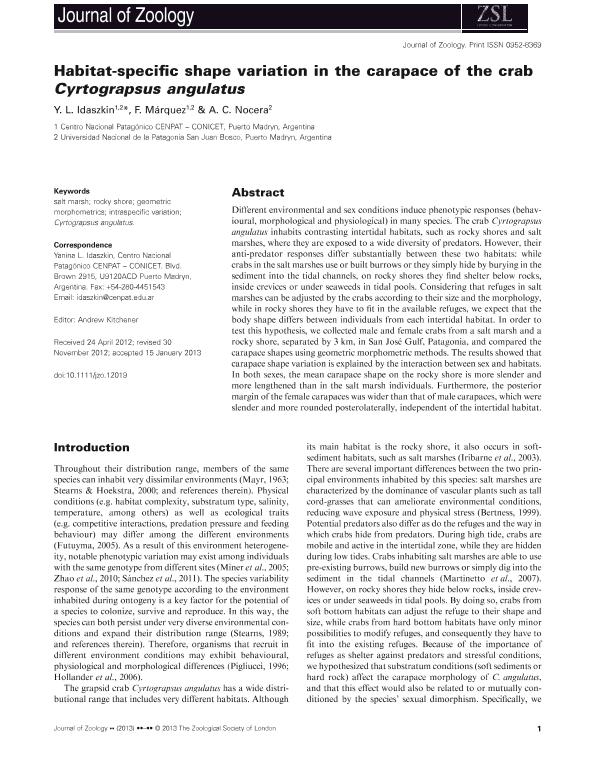Mostrar el registro sencillo del ítem
dc.contributor.author
Idaszkin, Yanina Lorena

dc.contributor.author
Marquez, Federico

dc.contributor.author
Nocera, Ariadna Celina

dc.date.available
2015-12-28T20:03:45Z
dc.date.issued
2013-06
dc.identifier.citation
Idaszkin, Yanina Lorena; Marquez, Federico; Nocera, Ariadna Celina; Habitat-specific shape variation in the carapace of the crab Cyrtograpsus angulatus; Wiley Blackwell Publishing, Inc; Journal of Zoology; 290; 2; 6-2013; 117-126
dc.identifier.issn
0952-8369
dc.identifier.uri
http://hdl.handle.net/11336/3259
dc.description.abstract
Different environmental and sex conditions induce phenotypic responses (behavioural, morphological and physiological) in many species. The crab Cyrtograpsus angulatus inhabits contrasting intertidal habitats, such as rocky shores and salt marshes, where they are exposed to a wide diversity of predators. However, their anti-predator responses differ substantially between these two habitats: while crabs in the salt marshes use or built burrows or they simply hide by burying in the sediment into the tidal channels, on rocky shores they find shelter below rocks, inside crevices or under seaweeds in tidal pools. Considering that refuges in salt marshes can be adjusted by the crabs according to their size and the morphology, while in rocky shores they have to fit in the available refuges, we expect that the body shape differs between individuals from each intertidal habitat. In order to test this hypothesis, we collected male and female crabs from a salt marsh and a rocky shore, separated by 3km, in San José Gulf, Patagonia, and compared the carapace shapes using geometric morphometric methods. The results showed that carapace shape variation is explained by the interaction between sex and habitats. In both sexes, the mean carapace shape on the rocky shore is more slender and more lengthened than in the salt marsh individuals. Furthermore, the posterior margin of the female carapaces was wider than that of male carapaces, which were slender and more rounded posterolaterally, independent of the intertidal habitat.
dc.format
application/pdf
dc.language.iso
eng
dc.publisher
Wiley Blackwell Publishing, Inc

dc.rights
info:eu-repo/semantics/openAccess
dc.rights.uri
https://creativecommons.org/licenses/by-nc-sa/2.5/ar/
dc.subject
CYRTOGRAPSUS ANGULATUS
dc.subject
GEOMETRIC MORPHOMETRICS
dc.subject
INTRASPECIFIC VARIATION
dc.subject
ROCKY SHORE
dc.subject
SALT MARSH
dc.subject.classification
Biología Marina, Limnología

dc.subject.classification
Ciencias Biológicas

dc.subject.classification
CIENCIAS NATURALES Y EXACTAS

dc.subject.classification
Ecología

dc.subject.classification
Ciencias Biológicas

dc.subject.classification
CIENCIAS NATURALES Y EXACTAS

dc.title
Habitat-specific shape variation in the carapace of the crab Cyrtograpsus angulatus
dc.type
info:eu-repo/semantics/article
dc.type
info:ar-repo/semantics/artículo
dc.type
info:eu-repo/semantics/publishedVersion
dc.date.updated
2016-03-30 10:35:44.97925-03
dc.journal.volume
290
dc.journal.number
2
dc.journal.pagination
117-126
dc.journal.pais
Reino Unido

dc.journal.ciudad
Londres
dc.description.fil
Fil: Idaszkin, Yanina Lorena. Consejo Nacional de Investigaciones Científicas y Técnicas. Centro Nacional Patagonico; Argentina. Universidad Nacional de la Patagonia; Argentina
dc.description.fil
Fil: Marquez, Federico. Consejo Nacional de Investigaciones Científicas y Técnicas. Centro Nacional Patagonico; Argentina. Universidad Nacional de la Patagonia; Argentina
dc.description.fil
Fil: Nocera, Ariadna Celina. Consejo Nacional de Investigaciones Científicas y Técnicas. Centro Nacional Patagonico; Argentina. Universidad Nacional de la Patagonia; Argentina
dc.journal.title
Journal of Zoology

dc.relation.alternativeid
info:eu-repo/semantics/altIdentifier/url/http://onlinelibrary.wiley.com/doi/10.1111/jzo.12019/full
dc.relation.alternativeid
info:eu-repo/semantics/altIdentifier/doi/http://dx.doi.org/10.1111/jzo.12019
Archivos asociados
